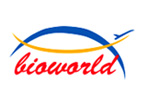Product Name :
CD300LB Recombinant Protein Swiss-Prot :
J9JID3 Host :
E.coli Tag :
Amino acid Sequence :
MIQGPESVRAPEQGSLTVQCHYKQGWETYIKWWCRGVRWDTCKILIETRGSEQGEKSDRVSIKDNQKDRTFTVTMEGLRRDDADVYWCGIERRGPDLGTQVKVIVDPEGAASTTASSPTNSNMAVFIGSHKRNHY Restriction sites :
NdeI-XhoI Background :
CD300LB, also known as CD300b, LMIR5, CLM-7, and IREM‑3, is a glycoprotein member of the immunoglobulin superfamily. LMIR5 is expressed on the surface of myeloid lineage cells. It forms noncovalent cis‑homodimers and cis-heterodimers with other CD300 family proteins, and the composition of these dimers affects the cellular response. Antibody cross‑linking of LMIR5 induces mast cell granule release and cytokine production as well as its tyrosine phosphorylation of LMIR5 (in human). LMIR5 interacts with TIM1 and TIM4 which regulate T cell activation and are themselves binding partners. TIM1 interactions with LMIR5 mediate mast cell activation and the accumulation of neutrophils at sites of TIM1 up‑regulation on damaged renal tubule epithelial cells. Acts as an activating immune receptor through its interaction with ITAM-bearing adapter TYROBP, and also independently by recruitment of GRB2. Soluble :
PBS, 4M Urea, PH7.4 Purification&Purity :
Transferred into competent cells and the supernatant was purified by NI column affinity chromatography and the purity is > 85% (by SDS-PAGE). Storage&Stability :
Store at 4°C short term. Aliquot and store at -20°C long term. Avoid freeze-thaw cycles. Expression vector :
pet-22b(+) BiowMW :
~18kDa Note :
For research use only, not for use in diagnostic procedure. concentration :
CD300LB Recombinant Protein Swiss-Prot :
J9JID3 Host :
E.coli Tag :
Amino acid Sequence :
MIQGPESVRAPEQGSLTVQCHYKQGWETYIKWWCRGVRWDTCKILIETRGSEQGEKSDRVSIKDNQKDRTFTVTMEGLRRDDADVYWCGIERRGPDLGTQVKVIVDPEGAASTTASSPTNSNMAVFIGSHKRNHY Restriction sites :
NdeI-XhoI Background :
CD300LB, also known as CD300b, LMIR5, CLM-7, and IREM‑3, is a glycoprotein member of the immunoglobulin superfamily. LMIR5 is expressed on the surface of myeloid lineage cells. It forms noncovalent cis‑homodimers and cis-heterodimers with other CD300 family proteins, and the composition of these dimers affects the cellular response. Antibody cross‑linking of LMIR5 induces mast cell granule release and cytokine production as well as its tyrosine phosphorylation of LMIR5 (in human). LMIR5 interacts with TIM1 and TIM4 which regulate T cell activation and are themselves binding partners. TIM1 interactions with LMIR5 mediate mast cell activation and the accumulation of neutrophils at sites of TIM1 up‑regulation on damaged renal tubule epithelial cells. Acts as an activating immune receptor through its interaction with ITAM-bearing adapter TYROBP, and also independently by recruitment of GRB2. Soluble :
PBS, 4M Urea, PH7.4 Purification&Purity :
Transferred into competent cells and the supernatant was purified by NI column affinity chromatography and the purity is > 85% (by SDS-PAGE). Storage&Stability :
Store at 4°C short term. Aliquot and store at -20°C long term. Avoid freeze-thaw cycles. Expression vector :
pet-22b(+) BiowMW :
~18kDa Note :
For research use only, not for use in diagnostic procedure. concentration :
Blocking peptide available as NCP0344P

 CD300LB Recombinant Protein
CD300LB Recombinant Protein 
 Datasheet
Datasheet COA
COA MSDS
MSDS SHIP
SHIP